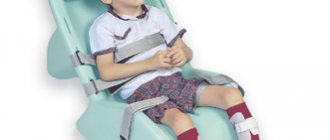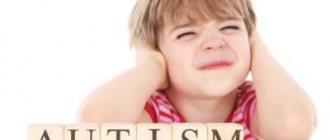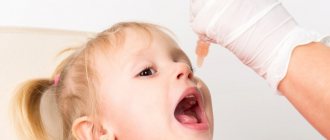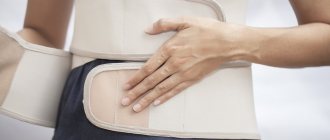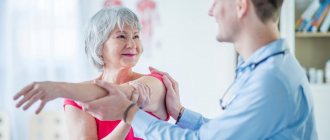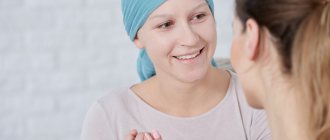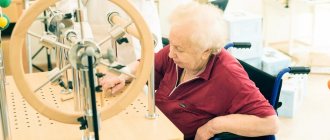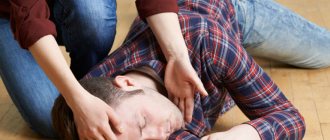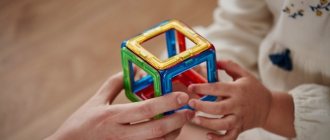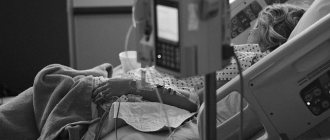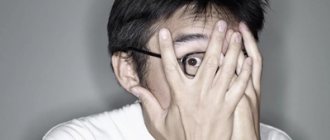Rehabilitation of cerebral palsy is carried out for all sick children; such a program will help return the child to a full life. It is carried out under the supervision of a doctor, the doctor assesses the degree of brain damage and selects the most effective methods. It will not be possible to get rid of the disease completely, but if you do all the exercises and training, you can regain lost functions: motor activity, speech and correct the psychological status. The most effective results are observed if rehabilitation of cerebral palsy is carried out in specialized centers.
It is better to start recovery in the early years, because at a young age a child’s brain is formed and actively developing. With this approach, it is possible to effectively compensate for the main disorders that arose during intrauterine development.
Forms of the disease
Cerebral palsy does not progress, because organic brain damage occurs during pregnancy. But in the absence of rehabilitation, these complications become permanent, and a person has to live with them all his life. The main signs of cerebral palsy are movement disorders, weakening of muscle tone, the appearance of pathological reflexes, and speech impairment. All these disorders can be significantly compensated for if a rehabilitation program is started in time.
Before starting treatment, the doctor determines the form of the disease:
- spastic diplegia - damage to the muscles of the back, legs and arms, rigidity of the lower extremities is more pronounced;
- double hemiplegia – the muscles of the arms are most affected, and mental retardation is observed;
- atonic-astatic type of pathology - deterioration of muscle tone throughout the body due to damage to the cerebellum and its pathways;
- hemiparetic form - unilateral lesion with predominant weakening of the upper extremities.
How is the rehabilitation of cerebral palsy carried out? – the first two forms are more amenable to correction than others, but with constant treatment and training, even with the most severe course of paralysis, good results can be achieved.
“Strengthening what is safe”: principles of rehabilitation of children with cerebral palsy
Medicine cannot completely cure cerebral palsy. The only way to combat this disease is maintenance therapy. The consequences of a malfunction in the central nervous system (hereinafter referred to as the CNS) can also be compensated for through high-quality rehabilitation. How to do this, experts from the capital’s Institute of Further Professional Education for Social Workers tell us.
With cerebral palsy, motor functions are most often affected. There may also be disturbances in intelligence, vision, hearing, sensitivity, speech, nutrition and even behavior - this is not the entire list of concomitant diseases. They sometimes have a much greater influence on the child’s adaptation to life.
“The main direction of rehabilitation for cerebral palsy is to resist the decline of functions, helplessness and impotence that the disease achieves,”
— says
Larisa Savina
, rehabilitation specialist, teacher at the Institute.
The expert identifies three principles of modern rehabilitation of children with cerebral palsy:
We act comprehensively.
Medical support alone is not enough, even if the child is observed by star experts. In addition to a pediatrician, neurologist, orthopedist or ophthalmologist, physical therapy instructors or physical therapists, a psychologist, speech therapist and special education teacher should be involved in the work. Interdisciplinary work can help the child and his family as much as possible.
We strengthen what is safe.
Children with cerebral palsy should not be deprived of movement, otherwise they may lose what they can. The best remedy here is physical therapy. It improves coordination, balance, strength, endurance, pain control, posture, gait and overall health. In addition to popular massage or traditional therapeutic exercises, this also includes lesser-known techniques - for example, neurodevelopmental therapy (Bobat concept, Voight method), reflexology, hippotherapy, etc.
We work systematically and follow a step-by-step approach.
All rehabilitation activities are carried out according to the principle: the main thing is not the diagnosis, but the real capabilities and resources of the child. There is no need to demand the impossible from a person, raise the bar and set records. Have you learned to use a spoon or hold a pose? Great, let's set our next goal! And be sure to praise your child for his results: this will make him want to achieve more.
“In Moscow there are rehabilitation centers
that help families with a child with cerebral palsy.
These include both hospitals and semi-hospitals; some of them have specialists who come to your home. But the most important thing is that rehabilitation work is carried out constantly, and not occasionally. Two or three specialized courses per year are good, but not enough. You need to stay in shape at home to resist the diagnosis. Here, a lot depends on the parents: develop the child’s self-care skills, train his motor skills, conduct classes to correct cognitive impairment,” recommends
Larisa Savina.
Press service of the Department of Labor and Social Protection of the Population of Moscow
Recovery stages
The first steps in the treatment of cerebral palsy are the most difficult - the child has lesions in the cerebral structures, which cause motor impairments. In the future, it will be easier to cope with pathology; as neural connections are restored and formed, it will be easier for the nervous system to adapt to new conditions.
There are several stages of recovery; such rehabilitation is carried out for cerebral palsy from an early age. It includes:
- preparing the nervous system for upcoming loads and movements;
- biomechanical effects to destroy neural connections and restore muscle tone;
- consolidation of the results obtained, stabilization of coordination of movements and self-care.
The second stage is the most difficult; many difficulties arise during this period. A complete restructuring of the nervous system is coming - the child will actually have to learn to walk again, talk normally and deal with stress.
“Strengthening what is safe”: principles of rehabilitation of children with cerebral palsy
With cerebral palsy, motor functions are most often affected. There may also be disturbances in intelligence, vision, hearing, sensitivity, speech, nutrition and even behavior - this is not the entire list of concomitant diseases. They sometimes have a much greater influence on the child’s adaptation to life.
“The main direction of rehabilitation for cerebral palsy is to resist the decline of functions, helplessness and impotence that the disease achieves,” says Larisa Savina , rehabilitation specialist, teacher at the Institute.
The expert identifies three principles of modern rehabilitation of children with cerebral palsy:
We act comprehensively. Medical support alone is not enough, even if the child is observed by star experts. In addition to a pediatrician, neurologist, orthopedist or ophthalmologist, physical therapy instructors or physical therapists, a psychologist, speech therapist and special education teacher should be involved in the work. Interdisciplinary work can help the child and his family as much as possible.
We strengthen what is safe. Children with cerebral palsy should not be deprived of movement, otherwise they may lose what they can. The best remedy here is physical therapy. It improves coordination, balance, strength, endurance, pain control, posture, gait and overall health. In addition to popular massage or traditional therapeutic exercises, this also includes lesser-known techniques - for example, neurodevelopmental therapy (Bobat concept, Vojta method), reflexology, hippotherapy, etc.
We work systematically and follow a step-by-step approach. All rehabilitation activities are carried out according to the principle: the main thing is not the diagnosis, but the real capabilities and resources of the child. There is no need to demand the impossible from a person, raise the bar and set records. Have you learned to use a spoon or hold a pose? Great, let's set our next goal! And be sure to praise your child for his results: this will make him want to achieve more.
“There are rehabilitation centers in Moscow that help families with a child with cerebral palsy. These include both hospitals and semi-hospitals; some of them have specialists who come to your home. But the most important thing is that rehabilitation work is carried out constantly, and not occasionally. Two or three specialized courses per year are good, but not enough. You need to stay in shape at home to resist the diagnosis. A lot depends on the parents here: develop the child’s self-care skills, train his motor skills, conduct classes to correct cognitive impairment,” recommends Larisa Savina .
Recovery methods
Rehabilitation methods for children with cerebral palsy are varied, they include ongoing treatment, physical therapy and training. Medicines are used as basic therapy, exercises and procedures help develop new skills and consolidate the results. To obtain a pronounced effect, the impact must be complex and targeted, therefore, to prescribe a program, you should contact specialized centers. A doctor in such an institution will be able to observe the patient and, if necessary, adjust rehabilitation.
Our team of rehabilitation doctors
All professionals involved in the rehabilitation of patients with movement disorders must continually develop their skills in observation, assessment and analysis of movements. Most of our movements are automatic. But in order to teach a child to move, a specialist must have a clear understanding of the algorithm and sequence of each movement.
Indeed, in order to better understand other people's movements, you need to learn to analyze your own. Our profession is closely related to the physical impact on the patient’s body, so we must know and subtly feel how much force can be applied, with what rhythm and intensity the exercises can be performed. We also teach this to parents.
Experienced rehabilitation doctors, whom we have gathered in our Center, will help you understand what exactly is wrong with your child. After observing his movements, they will conduct a diagnosis right at the initial consultation, and then set goals and objectives that they will focus on in further work with the patient.
It is very important not only to help the baby learn to roll over, hold his head up, sit, crawl, walk and feed himself, but also to avoid secondary deformities such as joint contractures, hip dislocations, ankle instability, etc. All these deformations significantly inhibit motor development.
A speech pathologist and a clinical psychologist work closely with rehabilitation specialists. We teach children to express their thoughts and desires: if it is not possible to voice them in language, then this can be done with the help of signs and cards. The satisfaction of being understood provides a powerful incentive for further development.
We are always happy to share what we know and can do for the rehabilitation of cerebral palsy. Come to our Center and we will work together for results.
To get a consultation
The life of every child is a separate story!
Rehabilitation of children with cerebral palsy
Rehabilitation of children with cerebral palsy
Rehabilitation of children with cerebral palsy in Moscow
Rehabilitation of children with cerebral palsy in Moscow
Vojta therapy and rehabilitation of children with cerebral palsy in Moscow
Hydrotherapy
This method is used in the process of pediatric rehabilitation to improve motor abilities and sensory activity. The rehabilitation room has a swimming pool with different depths, it is equipped with parallel bars and other auxiliary elements for therapeutic exercises. All classes are held individually: the therapist works with the child and at the same time teaches one of the parents. This helps improve the child-parent relationship, increase confidence levels and develop new motor abilities.
Classes are held for the purpose of:
- walking training;
- reducing spasticity;
- strengthening and development of muscles and joints.
Centers for rehabilitation of children diagnosed with cerebral palsy in Russia
Many parents are concerned about the question of where a child with cerebral palsy can undergo rehabilitation. In government institutions, the list of therapeutic measures is very often limited. It is often impossible to undergo comprehensive rehabilitation in a regular clinic at all. That’s why many parents turn to rehabilitation centers, which have experienced specialists and good equipment. Here is a small list of such clinics in Russia:
- German rehabilitation center, Radimichi, Bryansk region.
- Rehabilitation center of Professor Sevastyanov, Yoshkar-Ola, Republic of Mari-El.
- Institute of Clinical Rehabilitation, Tula.
- St. Petersburg Institute of Early Intervention.
- Clinic of Infantile Paralysis under the leadership of Umnov, St. Petersburg.
- , Saint Petersburg.
- , Saint Petersburg
- Children's psychoneurological hospital No. 18, Moscow.
- Kuntsevo Medical and Rehabilitation Center, Moscow
- "Primavera-Medica", Moscow
- Russian Academy of Medical and Social Rehabilitation, Moscow
In fact, there are many more clinics and centers, and they use different treatment methods. Some offer the opportunity to take the course for free, but you often have to wait in line. In many private clinics, services are paid. When choosing a rehabilitation center for children with cerebral palsy, you should definitely find out about its reputation, equipment and treatment methods that are used there, and the results of therapy in other patients.
Rehabilitation of children with cerebral palsy is a long process that takes years, and parents will have to prepare themselves for long and hard work. Rehabilitation methods for each child must be selected individually. The results largely depend on the degree of violation. Therefore, the doctor must warn parents to what extent the child’s motor, speech, and intellectual abilities can resume.
A virtual reality
This is an artificial world in which a child can identify himself and perform various actions, in other words, this is a real world that obeys the same laws of physics, only in virtual reality.
Artificial intelligence monitors changes that occur in the virtual world and provides the patient with new data and tasks for action. This therapy opens up great possibilities. The system is able to individually adapt to each patient, helping the doctor in the process of patient rehabilitation.
There are more than enough advantages of such virtual therapy, which actually helps patients, including:
- artificial intelligence perfectly adapts to the capabilities and characteristics of each patient, providing exercises that he can do;
- the ability to change the difficulty level of exercises;
- helps to measure the patient’s performance in exercises and use this data to develop further exercises for rehabilitation;
- patients are very happy and friendly about activities in the virtual world, which undoubtedly affects the general condition of the patient;
- in fact, entertainment contributes to patient care.
Sensory Integration
This therapy takes place in a special room – a snoezelen. The room is a multi-sensory environment designed to either stimulate or suppress the patient's core senses through music, various scents, colors, images and other sensory objects.
The environment is controlled, the patient is left to his own devices and has the right to manage his own time and enjoy the environment around him. In such a room, all 5 human senses can be active. The environment can be adjusted and adapted to a specific patient, which has a very effective effect on rehabilitation as a whole.
Sensory integration has the following goals:
- relaxation, pleasure and rest without the interference of the patient’s intellect and expectations from surrounding people, there are no failures in the environment;
- treatment of psychosomatic disorders;
- reduction of aggression, stress and depressive mood;
- activation of all human senses (vision, touch, hearing, taste, smell);
- increased concentration;
- the ability for people with disabilities to respond to stimuli in the created environment or, conversely, to limit the patient from certain ones;
- helps the patient understand and recognize his body in a specific space, improve the coordination of the body in movement in relation to the created environment and space;
- reduction of self-stimulation.
The ultimate goal of being in such an environment is complete sensory integration and the development of the ability of the central nervous system to respond to sensory information, process it and transmit it to the brain through the senses for the body's further response to surrounding objects and environment. This therapy is suitable for both children and adults.
Bobath method
This method of neurodevelopmental treatment was named after its creators, Bertha and Karel Bobath. The approach to treating patients with cerebral palsy is based on knowledge and development of the nervous system and its pathologies:
- sensory-motor;
- emotional and social development of young children;
- perceptual;
The program is completely individualized and applied exclusively by the hands of a therapist. The focus is on natural sensory nutritional feedback and musculoskeletal control training.
The principles of treatment are:
- learning to sense movement;
- motor pattern training;
- facilitating the natural movement pattern and inhibiting pathology;
- setting goals, taking into account the stage at which motor ability is, the age and abilities of the child, always occurs in close connection with the family;
- assistance in the development of normal motor skills of the child;
The success of achieving goals affects the development of the child’s fine motor skills and speech. Close cooperation with the family is a must.
Basic techniques
Training-load suit "Adele", Rehabilitation in virtual reality, System "UGUL", System "SPIDER", Therapeutic styling, Massage, Olfactotherapy, Neurocorrection, Game speech therapy, Dynamic AFC, Speech therapy vocals, Transcranial micropolarization, Bell therapy, Halotherapy, Bionithreads, Biocapsule.
Rehabilitation
accepts for rehabilitation treatment patients diagnosed with cerebral palsy and other consequences of damage to the central nervous system and musculoskeletal system. This chronic disease provokes a lack of muscle activity, poor coordination and mental deviations.
We provide comprehensive rehabilitation of children with cerebral palsy under the guidance of competent staff. The clinic’s specialists have extensive experience working with all forms of disorders and select personalized rehabilitation programs with high results for children and adolescents. Treatment for cerebral palsy should begin as early as possible, when the earliest manifestations of the pathology appear, possibly before an official diagnosis is made. Competent rehabilitation of patients with cerebral palsy allows one to achieve lasting positive results and improve a person’s quality of life in the future.
PADOVAN method
This method is also called neurofunctional reorganization of the brain. It is based on the human neurological system, on neuralgia of the development of speech, walking, thought processes, on neuroplasticity of the brain and development through the formation of new synapses.
During a PADOVAN session, several methods are combined: occupational therapy, physiotherapy and logotherapy. Exercises are used for the upper and lower extremities to promote speech learning, coordination of body movements, swallowing and breathing.
The method is effective in treating children:
- with developmental delays;
- with dyslexia;
- with learning problems (reading, numeracy and writing;
- with attention disorders;
- with the presence of hyperactivity.
Technical means for the rehabilitation of children with cerebral palsy
In the complex treatment of children with cerebral palsy, various technical means of rehabilitation are used. They help prevent various complications of the disease, such as persistent contractures. With their help, the child can sit and move independently, other movement disorders are compensated, hyperkinesia and violent movements are reduced, and the child develops a natural motor stereotype.
All technical means can be divided into simulators for the rehabilitation of children with cerebral palsy and auxiliary devices. But this division is rather arbitrary, since often auxiliary devices simultaneously play the role of simulators.
When choosing a simulator, it is important to take into account the child’s stage of development, his physical fitness and the degree of impairment. The following types of devices exist:
- Exercise machines to strengthen crawling skills. Children up to three years of age are trained in them. They allow you to develop coordination, stimulate the development of the vestibular apparatus, strengthen the muscles of the arms, legs, neck and shoulder girdle, improve intestinal motility, stimulate growth, and relieve some motor restrictions.
- Sitting trainers. They are a chair on wheels with belts and clamps, which allows you to secure the child’s body in the most natural position. Prevents the formation of contractures, curvatures of bones and spine. Reduces the number of involuntary movements, teaches the child to properly hold and control his body.
- Standing trainer. This product is a platform with an adjustable tilt and special locks. It strengthens muscles, improves breathing, bowel and bladder function, prevents bedsores, and allows children to better navigate the world around them and communicate with others.
- Walking trainer. This rehabilitation equipment is similar to walkers of different designs with a saddle, clamps and special handles. The simulator expands the child’s motor capabilities, strengthens muscles and bones, teaches children to properly fix their head, shoulders, and chest, stimulates growth, and serves to prevent contractures, bedsores, and obesity.
- Tactile simulators: massage mats, special treadmills, devices for palm massage. They improve the sensitivity of the hands and feet, relieve muscle spasms, and improve fine motor skills.
- Household exercise equipment. Special boards with door handles, hooks, latches, taps, switches that help the child improve household skills.
Medicines
Medicines are used mainly at a younger age, when problems with muscle tone are observed. Next, the drugs are prescribed as maintenance therapy to eliminate complications. Psychological disorders are also treated.
The doctor may prescribe the following medications:
- to stimulate muscle tone: Mydocalm, Baclofen, Dysport;
- medications to improve cerebral circulation: Piracetam, Lucetam, Biotredin;
- vitamins and mineral supplements to strengthen the body.
The doctor adjusts the dosage according to the child’s condition and the effectiveness of the therapy. Taking medications without a doctor's prescription is not recommended.
Exercise therapy
Therapeutic exercises help restore lost functions, normalize tone and prevent muscle wasting. It is recommended to perform exercises from an early age - this will help you quickly cope with weak tone and restore self-care.
The following program is recommended:
- physical exercises with a trainer - to develop a specific muscle group;
- kinesitherapy - “treatment with movement” and constant physical activity;
- mechanotherapy – performing approaches on specialized simulators in rehabilitation centers.
The main feature of the rehabilitation of children with cerebral palsy is that the effect appears only with systematic training. That is why you need to fully follow all the doctor’s recommendations and engage in physical therapy.
Beginning of rehabilitation
When should rehabilitation begin for children diagnosed with cerebral palsy? Many years of experience suggest that the best results can be achieved with early treatment. In addition, the disease tends to progress. Therefore, therapy should begin immediately after diagnosis. Children who were born with asphyxia or received birth injuries are treated from the first days of life. Comprehensive rehabilitation of children with cerebral palsy should be continuous.
Which specialists provide treatment?
If you suspect any motor disorders in a child, you should contact a neurologist. Children are under special supervision after cesarean section, rapid labor, stimulation of labor, or complicated pregnancy. An examination is indicated in case of a low Apgar score. A neurologist must examine all premature babies born with asphyxia, birth injuries, and hematomas.
If cerebral palsy is suspected, a number of additional examinations are prescribed:
- electroencephalography;
- electromyography;
- electroneurography;
- transcranial magnetic stimulation;
- neurosonography;
- MRI of the brain.
All this allows not only to confirm the diagnosis, but also to identify the degree of disorders and organic changes in the nervous system. After diagnosis, rehabilitation programs are developed. Children undergo treatment on an outpatient basis and visit physiotherapy rooms at clinics. Treatment in hospitals and sanatoriums is also provided. Now there are many rehabilitation centers that conduct classes with children using modern methods. Unfortunately, most of them are paid.
Neurostimulation
This method uses weak currents to stimulate neurons in the brain and spinal cord. This makes it possible to reduce the activity of inhibition in cerebral structures and resume motor activity. Using this method, it is possible to cope with chronic pain and paresthesias, which often arise as complications of cerebral palsy.
The decision to perform neurostimulation is made by the doctor based on the child’s condition. Such therapy is considered successful if it helps eliminate half of all complications.
Physiotherapy
Physiotherapeutic treatment is used as a complement to primary therapy; such procedures strengthen the body. They increase tissue regeneration, activate blood flow in muscles, bones and joints, improving cellular nutrition.
Modern methods of treating cerebral palsy include sessions of the following procedures:
- electrical stimulation;
- magnetic therapy;
- warming up;
- light therapy
Treatment is carried out in courses of 10-15 sessions. You need to visit the office strictly on schedule and not skip physical therapy. A referral can be obtained from a pediatrician or a specialized rehabilitation center.
Visit to a psychologist
Working with a psychologist is an important support for a child, which will help with social adaptation. The doctor conducts conversations and finds out what worries the patient in the first place. Game techniques, trainings and questionnaires are used. The program is selected individually according to leading methods for children with cerebral palsy.
During rehabilitation, the emphasis is on physical activity, but without overcoming psychological problems and barriers, it will be difficult for the child to return to social life. Only an integrated approach will consolidate the results obtained.
Rehabilitation of children with cerebral palsy: review of the effectiveness of various treatment methods
(March 26, 2021 Elena Noble, physical therapist, MPT)
In 2013, Iona Novak and her team compiled one of the most comprehensive, evidence-based reviews of various types of therapy for children with cerebral palsy https://www.ncbi.nlm.nih.gov/pubmed/23962350. Since then, it has been supplemented by more than two hundred new systematic reviews, and, in February 2021, it was updated with the title: State of the Evidence Traffic Lights 2021: Systematic Review of Interventions for Preventing and Treating Children with Cerebral Palsy ( State of the evidence Traffic Light 2021: A systematic review of interventions for the prevention and treatment of children with cerebral palsy). The latest review deepens and defines recommended therapies for children with cerebral palsy.
Nothing beats reading the entire article (available in full text in English) for a better understanding of the evidence and good visual illustrations (https://link.springer.com/article/10.1007/s11910-020-1022-z)
But in this publication we focus mainly on motor rehabilitation. Here is an example of what is included in the selected motor rehabilitation outcome area.
A big part of this review is the inclusion of higher levels of evidence for systematic reviews and randomized controlled trials. The results of the review are formalized in the new article above, which is an excellent tool for effective clinical interpretation of the therapies (interventions) studied in this study. This is what it looks like in the summary table of the review:
(link to more detailed tables: https://link.springer.com/article/10.1007/s11910-020-1022-z/figures/2)
- Therapies (interventions) that fall into the green category: GO! High quality evidence demonstrates the effectiveness of these methods. Recommended for use in practice.
- Therapies (interventions) that fall into the red category: STOP! High-quality evidence suggests that these methods are ineffective or harmful.
- Therapy methods (interventions) that fall under the yellow color: MEASURE! Minimal or inconclusive evidence requires monitoring of the results of these methods. Those methods that are higher and closer to green have more positive evidence of effectiveness and can be recommended.
These therapies are grouped under general treatment areas/outcomes. Examples of these groups include movement therapy outcomes, muscle tone management, contracture prevention and correction, hip monitoring, early intervention, pain, cognition, self-care functions, meal timing, and prevention. Note also that the size of the circles (indicating different types of interventions) is proportional to the number of randomized controlled trials evaluated for each type of intervention.
Green color:
- “Constraint-induced movement therapy” – CIMT (“Constraint-induced movement therapy”). Description of the method: https://en.wikipedia.org/wiki/Constraint-induced_movement_therapy. This is a method in which the movement of a healthy limb is limited to enhance the development of the affected limb.
- Targeted training with specific goals (for example, to develop specific skills)
- Workouts on the treadmill and on the ground with partial body weight support
- Occupational therapy after botulinum toxin injection
- Mobility training
- Individual corrective orthosis based on casts
- Bimanual training
- Power training
- Hippotherapy
Red color:
- Neurodevelopmental therapy in an initial passive format (traditional approach to the consistent development of motor skills in a child)
- Sensory integration (to develop motor skills)
- Craniosacral therapy
Yellow:
- Physical activity
- Using adhesive films (taping)
- Acupuncture
It is noteworthy that all green activities within this category include specific tasks and deliberate practice, high-intensity practice, with mandatory active participation
Of course, applying research findings to clinical practice is the next step. Researchers recommend doing this around child- and family-centered goals. Overall, it is extremely exciting to see how evidence-based therapies are growing and gaining traction in pediatrics. Client. This type of intervention is the basis for experience-dependent neuroplasticity and is well supported by principles of motor skill development and various studies. Red light interventions, in contrast, have a more passive approach, and this may be a major reason for their ineffectiveness.
Translation: Pankaja Kushwaha (BSc – LSE, MPhil – Glasgow University)
Forecasts
Rehabilitation of cerebral palsy depends on the form of the disease and the degree of brain damage. Usually, when therapy is carried out from an early age, the prognosis is relatively favorable - most disorders can be compensated for by primary school age. With a mild form of pathology, the manifestations of cerebral palsy will be almost invisible.
If you delay therapy and do not follow the doctor’s recommendations, the prognosis will be unfavorable. This is a child’s mental retardation and serious dysfunction of the musculoskeletal system. In case of cerebral palsy, parents and children are required to take a responsible approach and implement a rehabilitation program.
Social rehabilitation and adaptation of children with cerebral palsy
Social rehabilitation of children with cerebral palsy is no less important than physical rehabilitation. Such children must learn to live with disabilities, interact with family members, peers and society as a whole. It is very important to teach them to take care of themselves. If your condition allows, navigate in your native area or city. There are elements of social rehabilitation at all stages of treatment. A narrower program of adaptation to society includes:
- cultural adaptation and training in communication skills, establishing contacts with people;
- household adaptation with the possibility of self-service, movement in transport, shopping;
- training in social behavior;
- development of labor skills.
Medical and social rehabilitation of disabled children with cerebral palsy necessarily takes into account the psychological characteristics of each child. It is aimed at correcting individual violations of social behavior.
Patients with cerebral palsy can be very excitable, sensitive, and anxious. They perceive and remember information about the world around them more slowly, and are less likely to show initiative and independence.
Classes with children are conducted by specially trained teachers. Their task is to interest the child in acquiring new knowledge and gradually expanding its stock. The work is aimed at improving memory, attention, mastering mathematical knowledge, reading and a general understanding of the world. It is very important to improve fine motor skills and everyday adaptation. Also, sociocultural rehabilitation of children with cerebral palsy includes developing skills of proper communication in the family, with peers, and developing a positive attitude towards family and friends.
In many countries, a child with cerebral palsy can go to a regular school or kindergarten, and a special teacher works with him individually during lessons. By communicating in a group, children make friends from an early age, and healthy peers learn to treat people with disabilities correctly.
Unfortunately, we practically do not have such an opportunity. There are no teachers on staff at regular public schools who could provide individual lessons to sick children. Only children with mild disabilities who can take care of themselves and move relatively freely can attend lessons. But even in such cases, parents face negative attitudes. The management does not want to accept children, and peers, with the tacit support of parents, begin to mock the sick child. Therefore, many doctors advise sending children with cerebral palsy to specialized boarding schools.
